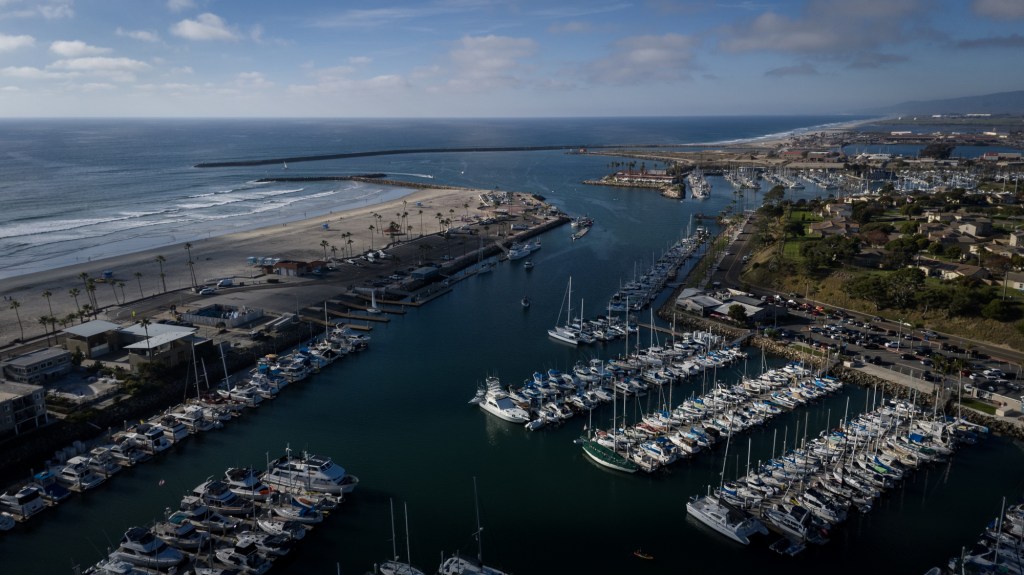City officials have a declared a local emergency to obtain help with efforts to clear a growing accumulation of sand that threatens to block the entrance to the Oceanside Harbor.
Parts of the harbor’s main channel have shrunk to as shallow as 10 feet, creating a navigation hazard, since the annual dredging that lowered the depth to 25 feet or more just before the Memorial Day weekend.
“The Coast Guard has closed other harbors when their mouth is 6 feet in depth, and a similar closure could happen (to Oceanside) if our channel continues to accumulate sediment,” said Jayme Timberlake, Oceanside’s coastal zone administrator, in a presentation last week to the Oceanside City Council.
The City Council voted unanimously to ratify the declaration made Nov. 18 by City Manager Jonathan Borrego, serving as the city’s director of emergency services.
“The U.S. Army Corps of Engineers will use the city’s emergency declaration to request emergency dredging authorization and funding from Congress,” Timberlake said.
Santa Barbara’s harbor was closed for three weeks in January 2023 after a winter storm pushed unusually large amounts of sand into the channel, according to online news reports. Even after an emergency dredging there, boats were allowed in and out only with a harbor patrol escort until further work was completed.
“There is a precedence for that here,” said Capt. Joe Cacciola of the Oceanside Sea Center at the harbor on Monday. The Sea Center has a building at the harbor’s marina and a fleet of five boats from 45 to 60 feet long used for whale-watching, sportfishing and other excursions.
“There have been times in the past when the harbor entrance was impassable,” Cacciola said, though it happens infrequently and probably not in the last 20 years.
The Sea Center rescheduled at least three boat trips in recent weeks because of large ocean swells, he said. The large swells hit the sandy shoal at the harbor entrance and create waves that can be difficult for vessels to navigate.
“Passenger safety is the primary concern,” Cacciola said.
It’s unusual for the Oceanside channel to silt up so much at this time of the year, the start of whale-watching season.
“My 60-foot boat (the Sea Star) draws 5 feet of water,” he said. “If they don’t get this emergency dredging by January or February, we are going to be in pretty bad shape.
“It doesn’t matter how experienced or skilled you are,” he said. “The ocean is the most powerful force on earth.”
Cacciola remembers a time in the 1970s when the harbor’s bait boat, named the City of Oceanside, went out for its regular supply of anchovies and was surprised by a big wave at the harbor entrance.
“It knocked the boat over sideways and the net got wrapped in the propeller,” he said. “Then another wave threw the boat onto the jetty.”
The entire crew had to rescued, he said. One crew member, a friend of his, was caught in the nets, pulled onto the rocks and drowned.
At least two rescues, none fatal, have been reported near the harbor entrance in the past month.
The Corps of Engineers is responsible for maintaining the harbor entrance, which is shared with the Camp Pendleton marina. The Corps pays for a contractor to do the dredging.
Sand pulled from the harbor is piped onto Oceanside beaches. The annual replenishment keeps the city’s northern beaches wide and sandy. But the harbor sediment only goes so far, and south of the municipal pier more than two-thirds of the city’s coastline is rocky and barren.
In addition to obtaining permits and funding, the work must fit into the schedule for the contractor, Manson Construction. Manson is now working at the Channel Islands Harbor in Oxnard.
“Oceanside is coordinating with Camp Pendleton to request that (the Corps of Engineers) performs off-cycle dredging sooner than the originally planned spring 2026 cycle,” said Shawn Davis, a Corps of Engineers spokesman, in an email last week from Los Angeles. “The earliest that could occur is in January 2026.”
Also being considered is the possibility of moving the harbor’s annual dredging from the spring to the fall.
The spring dredging occurs over about six weeks in April and May. It concludes with fresh sand on the beach in time for the Memorial Day weekend, the unofficial start of summer and the tourist season.
Oceanside’s harbor was built in the 1960s. It uses the same entrance as the Camp Pendleton marina built in 1942 at the outset of World War II. It is the only public harbor between San Diego and Dana Point in Orange County.
The city harbor has more than 900 boat slips, most of which are recreational with a long wait list for rentals. The marina has several restaurants and other small businesses popular with tourists.
New studies and a growing library of information about ocean currents, sea-level rise and other factors may indicate that fall dredging is better for the overall health of the harbor.
“Oceanside is requesting that (the Corps of Engineers) shift annual dredging from spring to fall,” Davis said.
“Placing sand in the fall puts material on the beach just before the high-energy winter wave season, so it can act as a buffer against winter storms, he said. “Additionally, grunion runs in the peak season of April to June may pause beach placement operations during spring dredging.”
The question is far from settled. Whether in spring or fall, the dredging has financial consequences.
“It isn’t clear if fall placement may result in less-direct summer recreational benefit as the beaches could potentially remain narrower during peak tourist months,” Davis said.
“The specific economic consequences of intentionally moving the dredging from spring to fall were not separately quantified,” he said.
The primary objective of any dredging is to ensure safe navigation of Oceanside Harbor, he said. Wider beaches are a secondary benefit.

